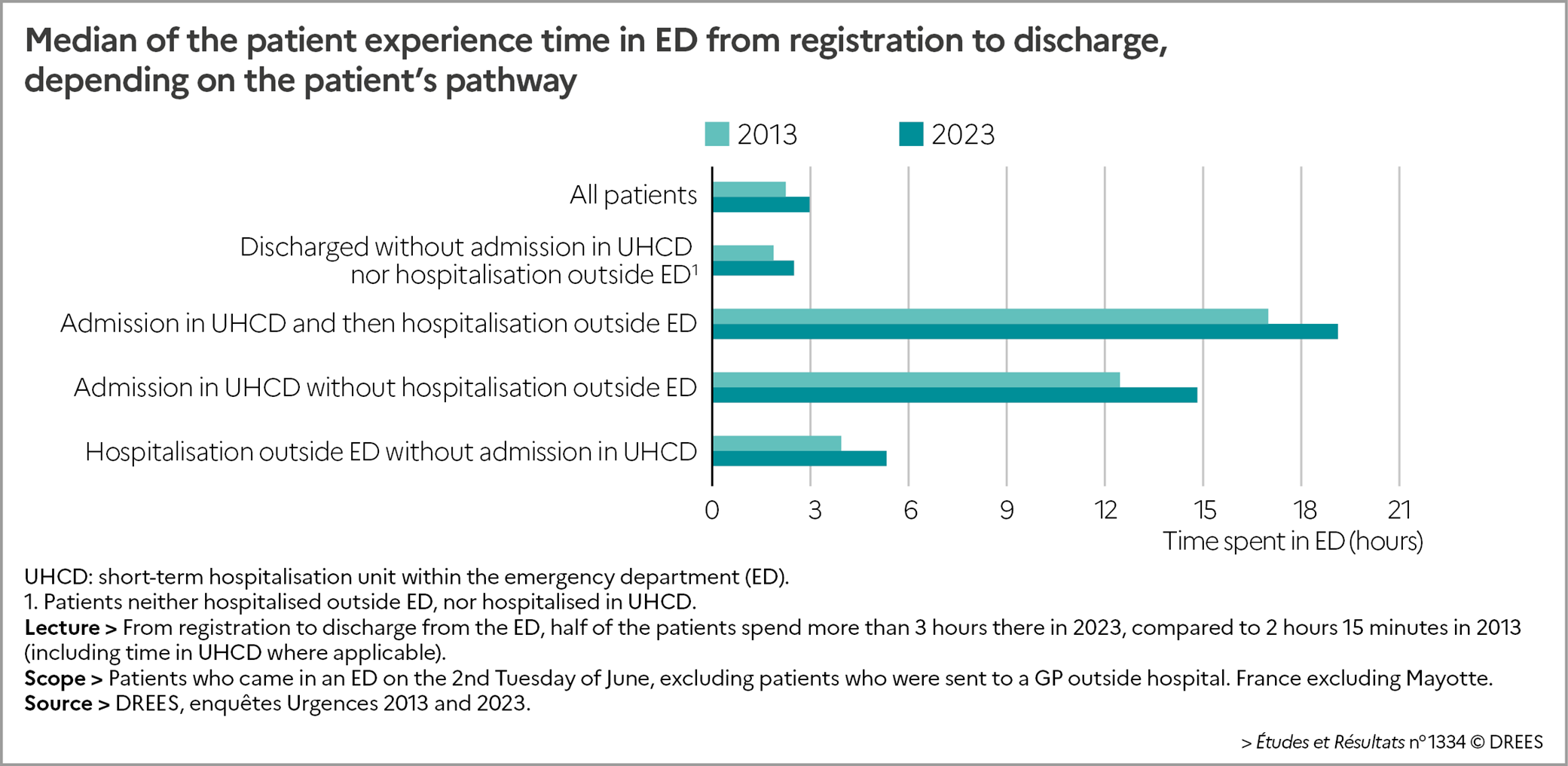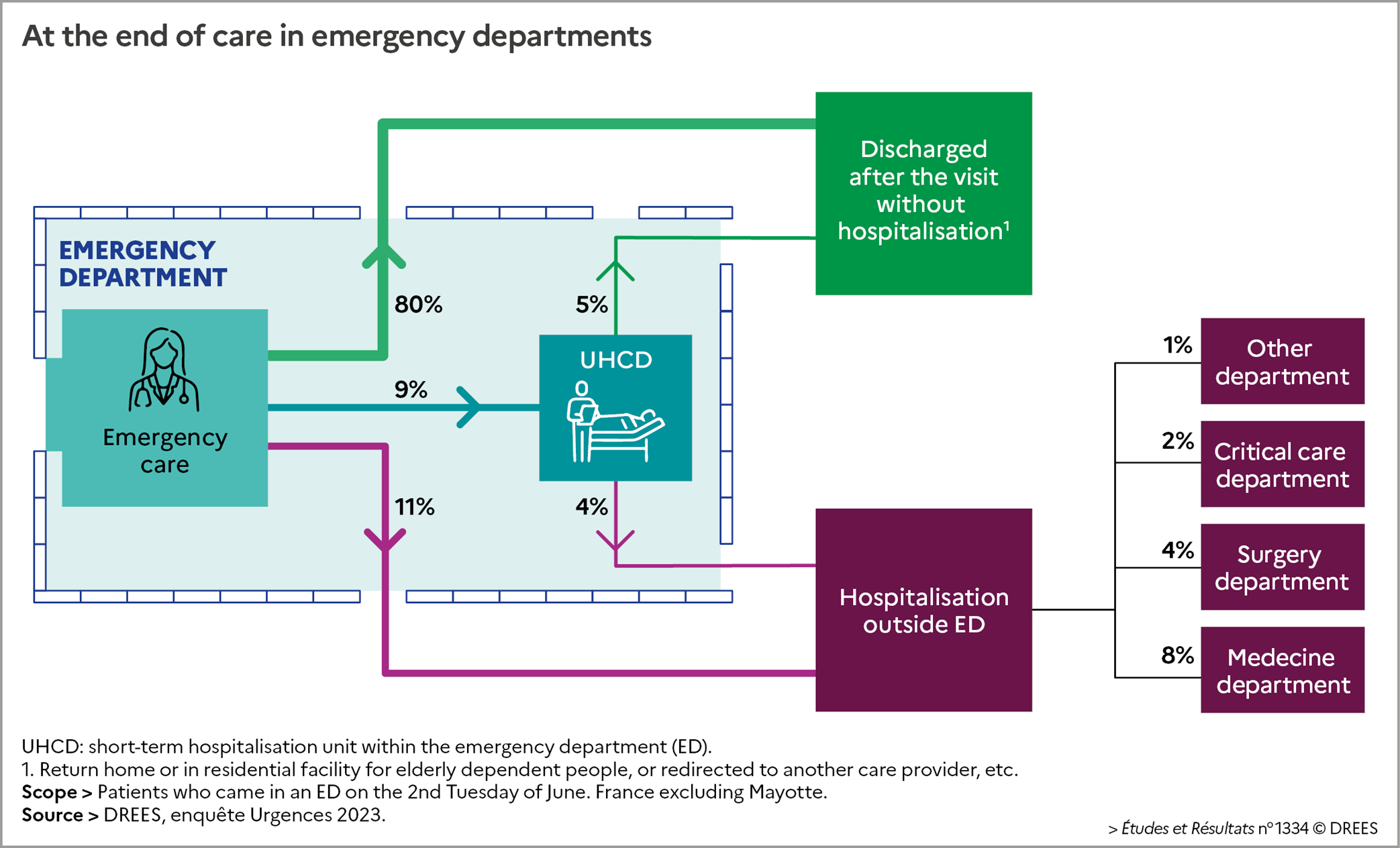The survey “Enquête Urgences 2023” was carried out among 58,500 patients who visited France's 719 emergency departments (ED) during 24 hours. It concerns all general and paediatric emergency departments in France, but not specialised emergency departments (e.g. dental, psychiatric, ophthalmological or gynaecological emergency departments, etc.). The survey was carried out on Tuesday 13 June 2023, from 8 am to 8 am the following day. As in 2013, the day of collection was chosen to avoid peak periods. As a result, the data are not representative of overall annual or weekly activity in ED, particularly peaks in activity generated by winter epidemics or observed on Mondays. The survey sheds light on the major structural changes that have occurred over the last ten years. The survey “Enquête Urgences 2023” was conducted in partnership with representatives of emergency professionals: the Société française de médecine d'urgence (SFMU), the Groupe francophone de réanimation et d'urgences pédiatriques (GFRUP), SUdF, Amuf, Fedoru and SNUHP.
Length of stay increases regardless of patient pathway
Over the last ten years, the increase in the number of ED attendances has been accompanied by an increase in the length of time spent in the department (patient experience time from administrative registration to discharge). In 2023, on an average weekday, half of the people seen in emergency departments (ED) spend more than 3 hours there, that is 45 minutes longer than in 2013 (graph below).
The time spent in ED varies greatly depending on the patient's pathway, but the increase is general. During their stay in ED, some patients are placed for observation in a short-term hospitalisation unit (UHCD) within the ED department: they have the longest stays.
Among patients discharged from the ED after the visit without being hospitalised outside ED and without having been admitted to UHCD (80% of patients), half of them spend more than 2 hours 30 minutes in ED, compared with 1 hour 50 minutes in 2013. For those hospitalised in another department after their visit in ED without having been admitted to the UHCD (11%), the median length of stay has increased from 3 hours 55 in 2013 to 5 hours 20 in 2023; and for those admitted to the UHCD during their stay in ED without subsequently being hospitalised in another department (5%), it has increased from 12 hours 30 to 14 hours 50.

The length of time spent in emergency also increases with the size of the department and the age of the patients
The length of stay increases with the size of the service: half of the patients spend less than 2 hours in ED receiving 40 patients or fewer for a 24-hour period, compared with 3 hours 50 minutes in those receiving more than 120 patients.
15% of patients spend more than 8 hours in ED, compared with 9% in 2013. These long stays very rarely concern children (3%), but do concern 36% of people aged 75 or over (compared with 24% in 2013). Elderly patients undergo more medical examinations and stays in UHCD than younger patients. Difficulties in finding a bed in another department for these patients, who are more often hospitalised on leaving ED, also affect these lengths of stay.
21% of patients had difficulties accessing primary care before coming to ED
Patients who came to ED on the day of the survey were asked about the reasons for coming to ED rather than elsewhere. Half of the patients replied that they had been referred directly by a doctor or transported by an emergency vehicle. 62% gave a reason related to the specific nature of the care provided by the emergency department: in particular, 35% of patients felt that only ED was medically suited to deal with the health problem for which they had come.
Among the other reasons for coming to ED, 21% of patients mentioned a problem obtaining a medical appointment elsewhere (GP absent, inability to find a medical appointment, including in case of a need of a rapid examination). In 2013, 14% gave this reason. In fact, the density of GPs in France has fallen between 2013 and 2023.
More patients came on the advice of the Samu-SAS than in 2013
When asked "Who advised you to come to emergency department?", 16% of patients said they came on the advice of the Samu-SAS (emergency care unit, phone number: 15), compared with 7% in 2013. Over the period 2013-2023, the use of the Samu has risen steadily, and even more sharply since the summer of 2022, when the public authorities encouraged people to call 15 before going to ED. 53% of patients came on their own initiative or were advised by someone close to them (59% in 2013).
Traumatology, gastroenterology and cardio-circulatory pathologies are the three main reasons for the use of emergency department
Traumatology (injuries, wounds, burns, etc.) accounts for a third of all ED visits in 2023, while gastroenterology and cardio-circulatory pathologies each account for one tenth. The reasons for the use of ED vary considerably according to the age of the patient. Up to the age of 5, children arrive with a variety of pathologies (fever, gastroenterological, respiratory and traumatic pathologies), while between the ages of 5 and 14, traumatic injuries dominate. Between the ages of 15 and 74, there is little change in the reasons for seeking care: a decrease in trauma, followed by a gradual increase in cardio-circulatory reasons, is observed with advancing age. From the age of 75 and over, 25% of ED visits are for trauma-related reasons, 16% for cardio-circulatory problems, 15% for other reasons, mainly due to an altered general condition, asthenia or abnormal biological results, and 9% for respiratory problems.
More examinations, care and medication for elderly patients than for younger ones
5% of patients are cared for in a life-saving emergency room during their visit, as in 2013. This is more frequent for people aged 75 or over (11%, whether directly after triage or later in their stay). Overall, diagnostic and treatment procedures and administration of medication increase with age, but the type of examinations also differs according to the pathologies associated with each age group.
As in 2013, three quarters of patients undergo diagnostic or treatment procedures, but in different proportions in 2023: less standard radiology, more scans, MRIs or ultrasounds, and more biological analyses. During their stay, 44% of patients received medication, mainly painkillers.
Overall, diagnostic and treatment procedures and administration of medicines increase with age, but the type of examinations varies, in line with the different pathologies according to age. For example, children aged 10 to 14, more than half of whom (56%) come to ED with traumatic conditions, are more likely to undergo imaging (53%) than older patients up to the age of 65.
The elderly, who are more likely to suffer from several pathologies, require more investigations: 94% of patients aged 75 or over undergo at least one procedure or administration of medication, including biological analyses (72% of all patients aged 75 or over), imaging (63%) or administration of medication (57%).
Fewer patients hospitalised in another department on leaving ED (after the visit)
In 2023, 15% of emergency patients are hospitalised in another department after the visit, compared with 20% in 2013 (see diagram below). In ten years, the number and proportion of patients hospitalised on leaving ED has fallen. Even when adding together admissions to UHCD (within ED) and hospitalisations outside ED, the proportion of patients concerned is lower: 20% of patients are admitted to UHCD or hospitalised in another department in 2023, compared with 23% in 2013.

The fall in the rate of hospital admissions after an emergency department visit is observed at all ages, in all types of health establishment and whatever the category of diagnosis at the end of the stay. There are several possible reasons for this decline: changes in medical practices, differences in patients' state of health, and the reduced availability of beds following the ongoing reduction in full hospitalisation capacity in healthcare establishments. In ten years, the number of full hospital beds has fallen by 11% (or 43,000 fewer beds).
Once the decision has been taken to hospitalise a patient (to a department other than the UHCD within the ED), finding a bed takes less than 15 minutes for half of the patients admitted, a time similar to that observed in 2013. However, for 10% of them, it takes more than 6 hours 10 minutes, compared with 3 hours 45 minutes in 2013.
More than three quarters of emergency patients return home at the end of their stay (they are discharged from the hospital), just as they did ten years ago. In addition, 4% of patients leave the ED before being formally discharged by ED, sometimes against medical advice, and 3% have been redirected to another care provider (e.g. outpatient care, general practitioner (GP)). Deaths in emergency departments are rare, accounting for 0.1% of visits.
Download the publication (french)
Learn more
- Delort L., Delage S. (2025, janvier). Samu : un taux de recours en hausse à la suite de la crise sanitaire et des mesures de régulation des urgences. DREES, Études et Résultats, 1325.
- Khaoua H., avec la collaboration de Suarez Castillo M. (2024, décembre). Passages aux urgences entre 2017 et 2023 : des dynamiques contrastées selon les départements. DREES, Études et Résultats, 1320.
- Demoly, E., et al. (2024, juillet). Urgences hospitalières en 2023 : quelles organisations pour la prise en charge des patients ? DREES, Études et Résultats, 1305.
